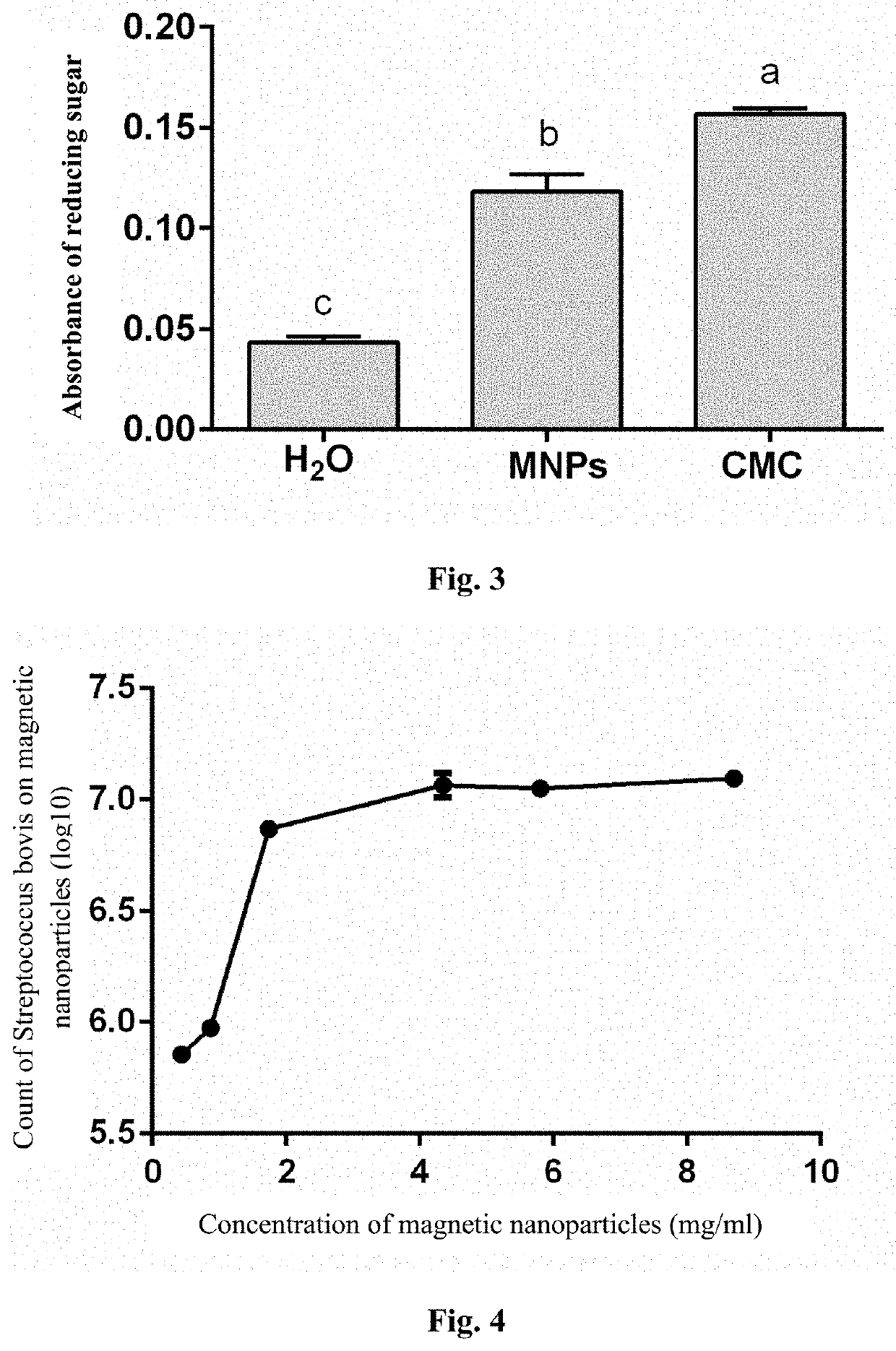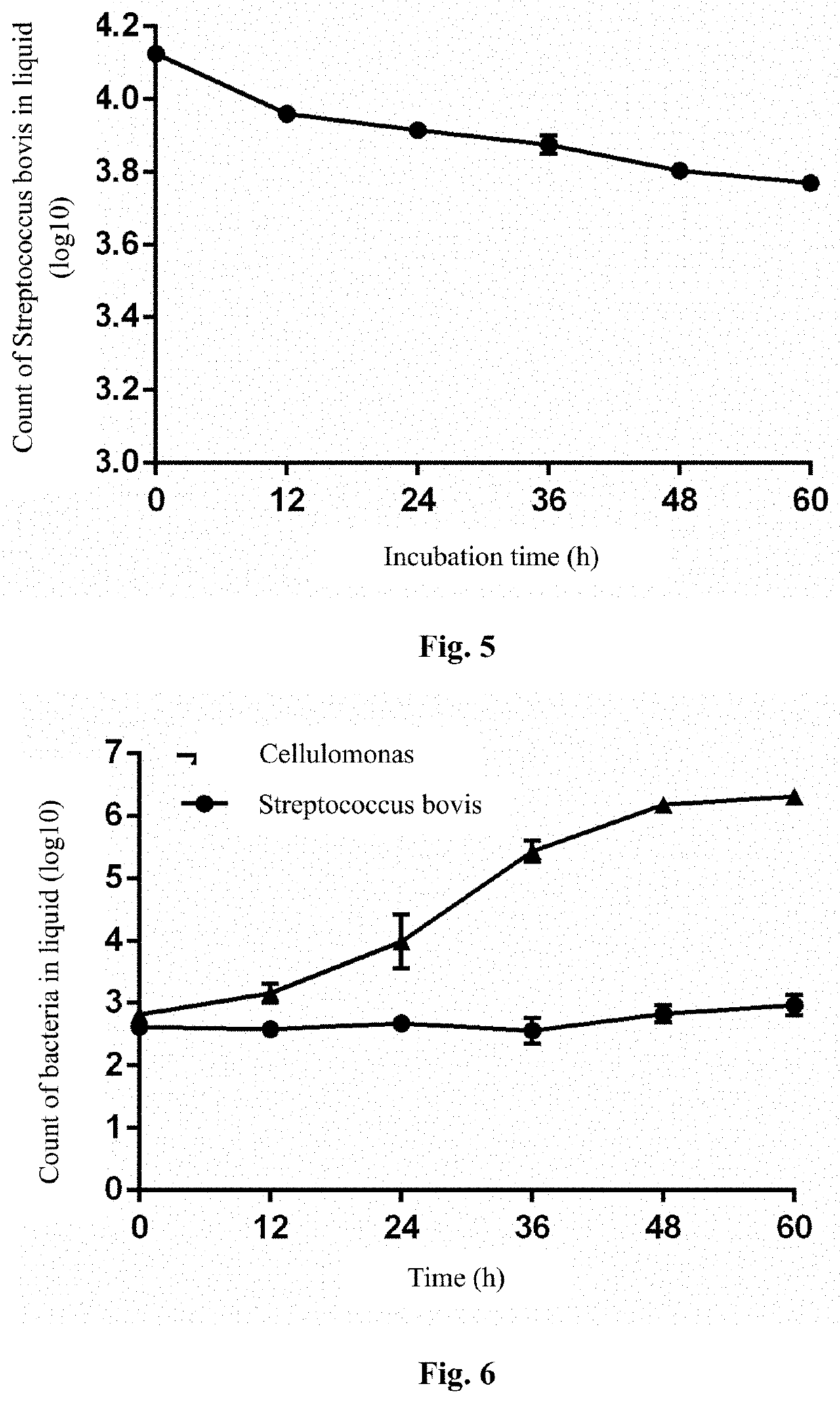Method for enriching and separating anaerobic fiber-degrading bacterium on the basis of cellulosic magnetic nanoparticles
- Summary
- Abstract
- Description
- Claims
- Application Information
AI Technical Summary
Benefits of technology
Problems solved by technology
Method used
Image
Examples
example 1
[0046]Preparation of an anaerobic medium. The formulation of the medium contains 1 g glucose, 1 g peptone, 6.0 g / L K2HPO4, 1.21 g / L CaCl2, 6.0 g / L KH2PO4, 12.0 g / L NaCl, 6.0 g / L (NH4)2SO4, 12.5 g / L MgSO4.7H2O, and 0.5 mL heme. The components were prepared according to the above-mentioned formulation and mixed. The mixture was purged with CO2 continuously for 4 hours after boiling. The pH was adjusted to 6.8. The mixture was added with 0.125 g of cysteine hydrochloride, and covered with a stopper quickly. The prepared culture medium was put into an anaerobic glove box, dispensed into anaerobic culture tubes, and autoclaved at a pressure of 121 MPa for 15 minutes to prepare the anaerobic media for further use.
[0047]Preparation of an anaerobic diluent. The formulation of the anaerobic diluent contains 6.0 g / L K2HPO4, 1.21 g / L CaCl2, 6.0 g / L KH2PO4, 12.0 g / L NaCl, 6.0 g / L (NH4)2SO4, 12.5 g / L MgSO4.7H2O, and 0.5 mL heme. The components were prepared according to the above-mentioned formu...
example 2
[0050]0.4970 g of FeCl2 and 2.7030 g of FeC3 were mixed, and added with 25 ml NaOH (1.0 mol / L) dropwise. Ultrasonication was performed for 30 minutes by using an ultrasonic machine. The mixture was separated using a permanent magnet at the bottom. The supernatant was sucked and replaced with an equal volume of ultrapure water. It was repeated several times until pH=7 to obtain magnetic nanoparticles for further use. The magnetic nanoparticles were characterized by using TEM, hysteresis curve and XRD. The results are shown in FIG. 2. It can be seen from FIG. 2 that an average size of the magnetic nanoparticles was 20 nm, and the saturation magnetization values were 3.3-24.9 emu / g.
[0051]8 g of Cellulose was dissolved in 400 ml of an alkaline solution (prepared by dissolving 14 g of NaOH, 24 g of urea in 162 g of water). The mixture was mixed thoroughly and stored at 4° C. overnight to obtain a cellulose dispersion for further use. The magnetic nanoparticles and the cellulose dispersio...
example 3
[0052]The main object of the example is to evaluate cellulose coating on surfaces of cellulose magnetic nanoparticles.
[0053]The cellulose magnetic nanoparticles were dissolved in the anaerobic diluent to prepare a solution of cellulose magnetic nanoparticles with a concentration of 17.4 mg / ml. 3 ml of The above-mentioned cellulose magnetic nanoparticle solution, water (negative control) and sodium carboxymethyl cellulose (positive control, 5 mg / ml) each were added to 1 ml of cellulase solution (1 mg / ml), placed in a water bath at 50° C. for 30 min, and then in a boiling water bath for 10 min. After cooled to room temperature, each of the solutions was added to 3 ml of DNS solution, and placed in a boiling water bath for 10 min. After cooled to room temperature, all of the solutions were adjusted to 25 ml. OD values were measured at a wavelength of 550 nm using a spectrophotometer. The results are shown in FIG. 3. It can be seen from FIG. 3 that after cellulase treatment, reducing su...
PUM
| Property | Measurement | Unit |
|---|---|---|
| Time | aaaaa | aaaaa |
| Time | aaaaa | aaaaa |
| Time | aaaaa | aaaaa |
Abstract
Description
Claims
Application Information
 Login to View More
Login to View More - R&D
- Intellectual Property
- Life Sciences
- Materials
- Tech Scout
- Unparalleled Data Quality
- Higher Quality Content
- 60% Fewer Hallucinations
Browse by: Latest US Patents, China's latest patents, Technical Efficacy Thesaurus, Application Domain, Technology Topic, Popular Technical Reports.
© 2025 PatSnap. All rights reserved.Legal|Privacy policy|Modern Slavery Act Transparency Statement|Sitemap|About US| Contact US: help@patsnap.com



